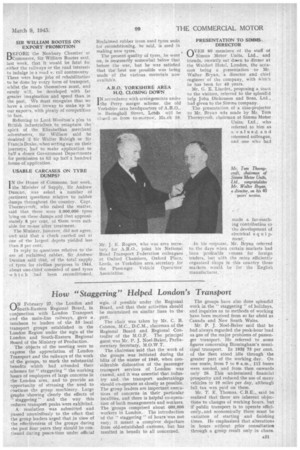How "Staggering" Helped London's Transport
Page 23

If you've noticed an error in this article please click here to report it so we can fix it.
ON February 27, the London and South-Eastern Regional Board, in conjunction with London Transport and the main-line railways, gave a luncheon to leaders of the 53 local transport groups established in the London Region under the asgis of the London and South-Eastern Regional Board of the Ministry of Production.
The objects of the meeting were to express the appreciation of London Transport and the railways of the work of the groups, to mark the substantial benefits which had attended their schemes for " staggering " the working hours of employees of large concerns in the London area, and to provide an opportunity of stressing the need to continue the group machinery. Large graphs showing clearly the effects of " staggering " and the way this reduces transport peaks were exhibited.
A resolution was submitted and passed unaninibusly to the effect that the group leaders urged that jn view of the effectiveness of the groups during the past four years they should be continued during peace-time under official gis,If possible under the Regional Board, and that their activities should be maintained on similar lines to the past.
The chair was taken by Mr. C. B. Colston, M.C.,.D.C.M., chairman of the Regional Board and Regional Controller of the M.O.P. The principal guest was Mr. P. J. Noel-Baker, Parliamentary Secretary, M.O.W.T.
The chairman said that the work of the groups was initiated during the blitz of the winter of 1940, when considerable dislocation of the passenger transport services of London was caused, and it was essential that industry and the transport undertakings should co-operate as closely as possible. The group leaders are important executives of concerns in their particular localities, and there is helpful co-operation of both managements and workers. The 'groups comprised about 600,000 workers in London. The introduction of the " staggering" of hours was not easy; it meant a complete departure from old-established customs, but has resulted in benefit to all concerned. The groups have also done splendid work in the " staggering" of holidays, and inquiries as to methods of working have been received from so far afield as Canada and New South Wales.
Mr. P. J. Noel-Baker said that he had always regarded the peak-hour load as gnu of the major problems of passenger transport. He referred to . some figures concerning Birmingham's municipal transport. In 1938 75 per cent. of the fleet stood idle through the greater part of the working day. On one route, from 7 to 9 a.m., 112 buses were needed, and from then onwards only 26. This undermined financial prosperity and reduced the use of many vehicles to 19 miles per day, although full tax was paid on them.
Mr. T. E. Thomas, C.B.E.,, said he realized that there are inherent objections to changes of working hours, but if public transport is to operate efficiently.and economically there must be variation of starting and finishing times. He emphasized that alterations in hours without prior consultation through a group result only in chaos.





















































